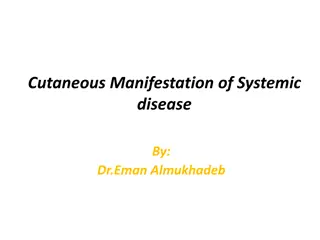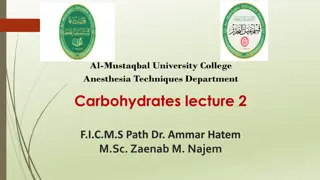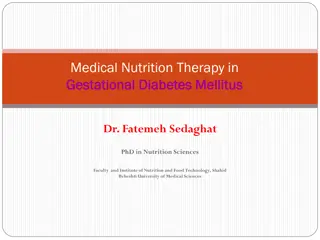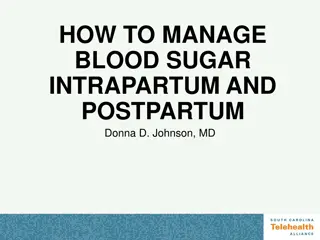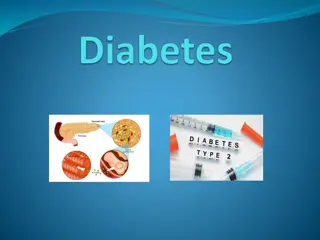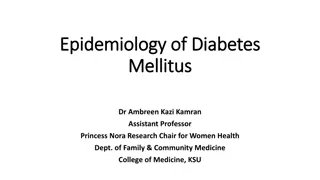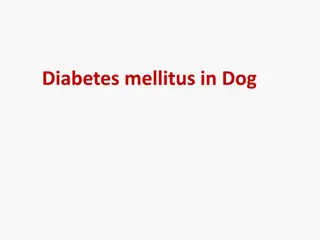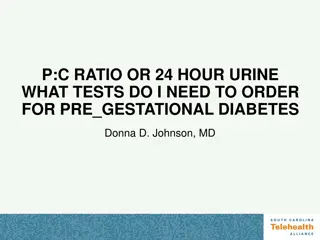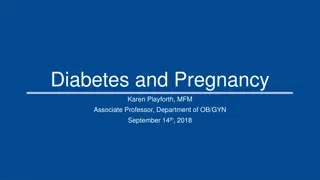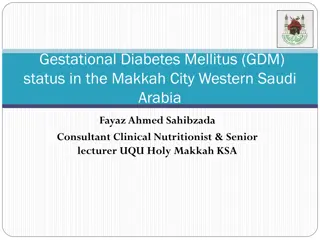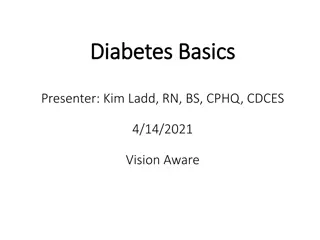Pathogenesis and Epidemiology of Gestational Diabetes Mellitus
Gestational Diabetes Mellitus (GDM) is a condition affecting pregnant women, characterized by glucose intolerance. This article explores the normal physiology of pregnancy, the pathophysiology of GDM, risk factors, prevalence in Iran, and the impact of new diagnostic criteria on GDM rates.
Download Presentation

Please find below an Image/Link to download the presentation.
The content on the website is provided AS IS for your information and personal use only. It may not be sold, licensed, or shared on other websites without obtaining consent from the author.If you encounter any issues during the download, it is possible that the publisher has removed the file from their server.
You are allowed to download the files provided on this website for personal or commercial use, subject to the condition that they are used lawfully. All files are the property of their respective owners.
The content on the website is provided AS IS for your information and personal use only. It may not be sold, licensed, or shared on other websites without obtaining consent from the author.
E N D
Presentation Transcript
Gestational Diabetes Mellitus Pathogenesis and Epidemiology F.Sarvghadi M.D Associate prof. Research institute for endocrine sciences. Shahid Beheshti University of Medical Sciences.
Outline Normal physiology of pregnancy. Review of pathophysiology of GDM. Risk factors of GDM. Reported prevalence in Iran. Impact of new criteria on prevalence of GDM Conclusion
Introduction Metabolism comes from the Greek word meaning to change Pregnancy is associated with major changes in metabolic processes and endocrine function.
Maternal physiologic adaptations Growth and development of the fetus. Providing the fetus with adequate stores of energy and substrates needed for transition to extra uterine life. Maternal needs for increased physiologic demands of pregnancy. Providing energy and substrate stores for pregnancy , labor and lactation.
Physiology of pregnancy Pregnancy is primary an anabolic state: 1- Increase food intake and appetite. 2- Around 3.5 kg of fat is deposited. 3- New protein synthesis is about 900 g. 4- The energy cost of reproduction is estimated at 75000- 85000 Kcal.
Utilization of maternal fuels by fetus Glucose and 3.C intermediates ( 6 mg/kg/min ) Nitrogen and amino acids ( 54 mmol/D ) Triglycerides and cholestrol ( poorly transferring ) Ketone bodies ( transfer freely).
Maternal fetal substrate, hormone relationship Placenta Mother Fetus Glucose Glucose Amino acids Amino acids FFA Ketones Glycerol FFA Ketones Glycerol Insulin Glucagon HPL Insulin Glucagon Human GH Homko CJ et al. Semin Reprod Endocrinol 1999 ; 17 : 119 125 .
2-Insulin metabolism during pregnancy Insulin degradation is increased by liver and placenta Insulin secretion is increased ( beta cell hypertrophy ) due to insulin resistance.
Insulin requirement during pregnancy Metzger BE , Freinkel N. Biol Neonate 1987 ; 51 : 78 85 .
3- Hepatic glucose production a) Early pregnancy: Insulin sensitivity Glucose production Lipogenesis Anabolic state for mother and fetus
b) Late pregnancy: Anti-insulin hormones Increase insulin resistance Beta cell hypertrophy Hyperinsulinemia Increase insulin degradition Lipolysis Accelarated starvation ( hyperketonemia ) Hypoaminoacidemia ( fetus storage ) Anabolic state ( fetus ) Catabolic state in mother
Fuel disposition in pregnancy ( overnight fast ) Placenta Mother Anabolic Fetus Anabolic I) Early II)Late Catabolic Anabolic
Anti-insulin hormones of pregnancy HCS ( hpl ): The strogest hormone GH like effect Lipolysis - Liopogenesis Insulin resistance Progestrone - Estrogen Insulin resistance beta cell hypertrophy cortisol secretion Cortisol ( free and total ) Insulin resistance, IRS-1
Prolactin -Placenta GHv. beta cell hypertrophy and insulin secretion. Leptin Adipokines Insulin resistance TNF - INL6 ( ? ) GH like effect Mills JL, et al. Metabolism 1998 ; 47 : 1140 1144
Absorptive and postabsorptive state during pregnancy Fed state Fasting state
Maternal adaptation The maternal response is characterized by a switch from carbohydrate to fat utilization that is facilitated by both insulin resistance and increased plasma concentrations of lipolytic hormones After an overnight fast the maternal fasting capillary whole blood glucose concentration falls , while plasma ketone and free fatty acid concentrations rise Mother preferentially use fat (eg, free fatty acids, triglycerides, ketone bodies) Preserve much of the available glucose and amino acids (especially alanine) for the fetus
Gestational Diabetes Mellitus Glucose intolerance of variable degree with onset or first recognition during pregnancy. WHO Consultation Group.. Geneva:1999:1-59
Factors mediating predisposition to G.D.M I ) Precursors of T2DM: Weight age ethnicity family history PCOD II) Specific genetic status: TIDM ( HLA DR3-4 GAD ab. ) MODY Mutation of mitochondrial DNA etc
Risk factors Obstet Gynecol Clin N Am 37 (2010) 255 267
Maternal-Fetal metabolism Anabolic phase: - Normal or increased sensitivity to insulin - lower plasma glucose level - lipogeneses, glycogen stores increases Catabolic phase (Accelerated starvation): - Maternal insuln resistance - Increased transport of nutritients trough placental membrane - lipolysis Cousins L. Diabetes 1991 ; 40 ( Suppl-2 ): 39 43 .
Circulating concentration of nutrient fuels In normal pregnancy: Accelerated starvation FPG Lipolysis and insulin resistance TG Cholesterol FFAs Glycerol Shift to fetus Amino acids In GDM: Basal and postprandial concentration of glucose, FFAs, amino acids, TG.
Pathophysiology of GDM The development of gestational diabetes is associated with a much greater severity of insulin resistance than normal pregnant women. The degree of insulin resistance seems to be influenced by obesity & inheritance. Gestational diabetes mellitus occurs when a woman's pancreatic function is not sufficient to overcome the insulin resistance. GDM occurs as a result of a combination of insulin resistance and decreased insulin secretion. Barbour LA et al. Diabetes Care 2007 ; 30 ( Suppl 2 ): 112 119 .
Fuel mediated teratogenesis Pedersen Freinkel Hypothesis P L A C E N A Silverman BL . Diabetes Rev 4:21-35 1996
GDM outcomes Polyhydramnios Vaginal candidosis. Hypertension. UTI Macrosomia Birth trauma dystocia Neonatal hypoglycemia- hypocalcemia hypokalemia- hyperbilirubinemia Nature ( genetic ) Obesity, IGT& DM Nurture (intrauterine environment ) in childhood
Clinical implications. Pregnancy as a state of facilitated anabolism. Pregnancy as a state of accelerated starvation. Pregnancy as a state of diabetogenic state.
Prevalence GDM complicates approximately 1% to 14% of all pregnancies. ( 5% - 6% ) In low-risk populations, such as those found in Sweden, the prevalence in population-based studies is lower than 2%. In high-risk populations, such as the Native American Cree, Northern Californian Hispanics and Northern Californian Asians, reported prevalence rates ranging from 4.9% to 12.8%. Curr Diab Rep (2010) 10:224 228
Reasons for differences in reported prevalence Different diagnostic criteria Different screening policies Different definitions, screening strategies and awareness of type 2 diabetes Maternal age Racial/ethnic composition of population Obstet Gynecol Clin North Am. 2007 June ; 34(2):
This report is based on 36,403 KPCO singleton pregnancies occurring between 1994 and 2002 and examines trends in GDM prevalence among women with diverse ethnic backgrounds Diabetes Care 28:579 584, 2005
The prevalence of GDM among KPCO members doubled from 1994 to 2002 (2.1 4.1%, P 0.001) Prevalence of GDM is increasing in a universally screened multiethnic population Given the etiology of type 2 diabetes , the observed increase probably reflects the well-documented obesity epidemic
92 153 1 Different protocol for diagnosis
Aim: Impact of new IADPSG criteria on diagnosis of GDM compared with ADA criteria Diabetes Care 2010 33:2018 2020,
Results ADA criteria identified 12.9%women with GDM ADPSG criteria identified 37.7% women with GDM The IADPSG criteria increased GDM prevalence nearly threefold
Epidemiological studies in Iran Larijani B, et al. Cost analysis of different screening strategies for gestational diabetes mellitus. Endocr Pract 2003;9:504 509. Keshavarz M, et al. Gestational diabetes in Iran: incidence, risk factors and pregnancy outcomes. Diabetes Res Clin Pract 2005;69:279 286. Hadaegh F , et al. Prevalence of gestational diabetes mellitus in southern Iran (Bandar Abbas City). Endocr Pract 2005;11:313 318. Hossein-Nezhad A et al ,Prevalence of gestational diabetes mellitus and pregnancy outcomes in Iranianwomen.Taiwan J Obstet Gynecol. 2007 Sep;46(3):236-41 Maghbooli Z et al ,Relationship between leptin concentration and insulin resistance .Horm Metab Res. 2007 Dec;39(12):903-7 Shirazian N et al, Comparison of different diagnostic criteria for gestational diabetes mellitus based on the 75-g oral glucose tolerance test: a cohort study . Endocr Pract 2008 Apr;14(3):312-7 Shirazian N et al ,Screening for gestational diabetes: usefulness of clinical risk factors .Arch Gynecol Obstet. 2009 Dec;280(6):933-7
Year Diagnostic method Prevalence % Author Sample size Tehran 2003 50&100g GTT 2416 4.7 Larijani Bandar- abbas 2005 50&100g GTT 800 8.9 Hadaegh Shahrood 2005 50&100g GTT 1310 4.8 Keshavarz Hosseinnezad Tehran 2003 50&100g GTT 2416 4.7 Tehran 2007 50&100g GTT 741 7 Maghbooli 75g GTT Tehran 2008 670 6.1 Shirazian Tehran 2009 75gGTT 924 7.4 Shirazian
To examine trends of obesity and abdominal obesity among Tehranian adults during a median follow-up of 6.6 years. BMC Public Health 2009, 9:426
To determine secular trends of overweight and obesity among Iranian adults (25 64 years old) within an 8-year period (1999 2007) Estaghamati AR et al. Diabetes Care 2008 ;31- 96-98
0verweight Obesity 1999 32.2% 13.6% 2005 35.8% 19.6% 2007 36.3% 22.3% Estaghamati AR et al. Diabetes Care 2008 ;31- 96-98
Conclusion Pregnancy is characterized by insulin resistance and hyperinsulinemia, thus it may predispose some women to develop diabetes. Gestational diabetes occurs when pancreatic function is not sufficient to overcome the insulin resistance created by changes in diabetogenic hormones during pregnancy . Prevalence of GDM in a population is reflective of the prevalence of type 2 diabetes in that population. The prevalence of GDM in Iran varies between 4.7% and 8.9% ,which represents a moderate prevalence rate. Based on increasing trend of obesity in Iran, it seems that the prevalence of GDM is also increasing . Practical bulletin , ACOG 2013 :137; 406- 416
Hormones associated with modifications in insulin secretion and action Insulin concentration Estrogens Insulin binding Glucose transport Progesterone Insulin binding Insulin-induced hepatic Gluconeogenesis
Hormones associated with modifications in insulin secretion and action . Insulin resistance Cortisol Phosphorylation of insulin receptor IRS-1 hPL, GH Insulin sensitivity Insulin secretion Insulin synthesis Utilization and glucose oxidation cAMP metabolism -cell number -cell mass Leptin Insulin resistance Glucagon Insulin resistance
Early pregnancy Increased glucose-stimulated insulin secretion Unchanged or enhanced peripheral (muscle) insulin sensitivity Unchanged basal hepatic glucose production Normal or slightly improved glucose tolerance Normal sensitivity to the blood glucose lowering effect of exogenously administered insulin. Late pregnancy Rising concentrations of several diabetogenic hormones Increased peripheral insulin resistance Progressive increase in basal & postprandial insulin (up to 2 fold in third trimester) lower insulin action in late normal pregnancy than in non pregnant women (50-70%) Basal endogenous hepatic glucose production increases by 16 30%




